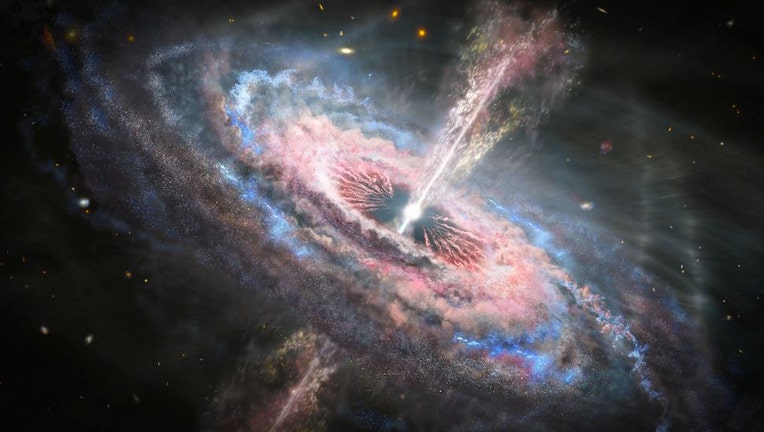Astronomers discover what could be universe's brightest object with black hole gobbling a sun a day

This is an illustration of a distant galaxy with an active quasar at its center. A quasar emits exceptionally large amounts of energy generated by a supermassive black hole fueled by infalling matter. (Photo from NASA, ESA and J. Olmsted (STScI)
Astronomers made an unusual discovery after spotting a quasar with a black hole growing to the extent it swallows the equivalent of a sun each day.
The quasar, considered the brightest object in the universe, shines 500 trillion times brighter than the sun, according to the Associated Press.
Australian researchers reported their findings in the scientific journal Nature Astronomy.
RELATED: Blast off! India soars into 2024 with space mission to study black holes
Based on their data, researchers explained that the record-breaking quasar is eating up the equivalent of 370 suns annually, about one a day.
Separately, the mass of the black hole is roughly 17 to 19 billion times larger than the sun, but the team explained that more research is needed to understand the rate of the quasar's growth.
RELATED: New NASA app lets you track International Space Station in real time
The European Southern Observatory first spotted the object in 1980 when it was first believed to be a star. However, scientists later determined it was a quasar in 2023.
What is a quasar?
A quasar is a supermassive black hole that grows by consuming large amounts of gas. The gas, in the form of a spiraling "accretion disk" around the black hole, can become very hot and emits light.
According to Space.com, the disk and spin of the black hole and the magnetic fields between the two objects is the source that gives quasars much of their brightness.
Quasars are formed when an event causes a large amount of gas to pile onto a central supermassive black hole in a galaxy.
The Associated Press contributed to this report. This story was reported from Washington, D.C.

